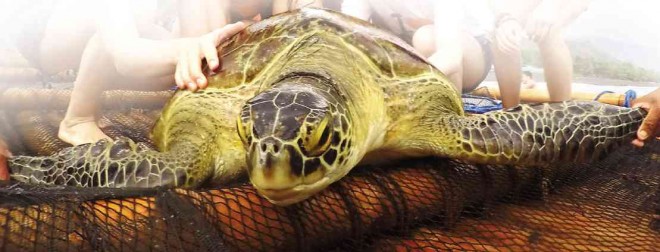Rain suddenly poured at the break of dawn as 20 students and two instructors boarded the four-layered bamboo raft in Barangay Malabor, Tibiao, Antique province.
They were about to experience “lambaklad” fishing in the Malabor Coast, a rich fishing ground and believed to be a highway of migratory fish, on the raft with the 21 “buso” (crew) led by one “maestro” (master-fisherman). Lambaklad is derived from the Kinaray-a words, “lambat” which means net and “baklad,” meaning corral. It is one of the biggest fish traps in the country.
“We were all chilling due to the cold rain, but our feeling was indescribable as we experienced the lambaklad fishing,” said Hillary Mae Baticados, one of 14 students from the University of the Philippines-Visayas (UPV) in Miag-ao town, Iloilo province, who joined the Antique Heritage Tour.
The students were with two instructors and six foreign medical students from Work the World, an organization that arranges international health-care internships and volunteer programs.
As the raft was getting closer to the cod-end of the bag, everyone was eager to see the catch.
“There is a baby pawikan (sea turtle)!” exclaimed Andres Mateo, one of the crew.
Both students and fishermen helped in pulling the heavy bag. They were surprised to see two sea turtles—an adult male and a juvenile male—trapped inside the bag with a variety of fish—cavalla, tuna, mackerel, hardtail scad, round scad and barracudas.
The adult weighed more than 90 kilos while the juvenile was about 10 kilos.
READ: 49 rescued marine turtles released back to sea
Alison Barwick, one of the foreign students, said she was touched when she saw the turtles crying as the creatures were placed on the raft. “They really shed tears but we whispered to the turtles that we will release them back to the sea,” she added.
Turtles have eyelids to protect their eyes from sunlight. Though they look like crying, they are actually excreting salt water.
They are able to see well in water but not on land.
Sea turtles are also color-blind.
When they reached shore, the turtles were slowly released by the students about 7 a.m. of May 10, an hour after they were caught.
READ: Wounded hawksbill turtle treated, released back to sea
“It was my first time to catch a sea turtle so the experience evoked mixed emotions. I was of course happy that they were released since they are endangered, but a tad saddened that I had to let go such beautiful creatures after getting a glimpse of their beauty,” said Rhoda Corda, a UPV teacher.
Humanities professor Rei Hontanar said it was a once-in-a-lifetime experience. “We are happy that we made a difference to the two creatures,” he said.
Pawikan or Green Sea Turtle (Chelonia mydas), are classified as endangered by the International Union for Conservation of Nature and Natural Resources, and Convention on International Trade in Endangered Species of Wild Fauna and Flora.
Under the Wildlife Resources Conservation and Protection Act of 2001, it is a crime to kill, injure, trade, hunt and possess endangered species, and the punishment is two to 12 years imprisonment and a fine ranging from P5,000 to P1 million.
READ: 7 live, 140 chemically preserved hawksbill turtles found in Palawan
Nick Calawag, owner of Jereos-Calawag lambaklad fishing, said that since his group established the lambaklad fishing in Tibiao, many sea turtles and whale sharks had been trapped but released to the sea.
It has been the tradition of fishermen to free every entangled turtle because they believe the creatures would give them good luck and bountiful harvest.
“The frequent occurrence of these endangered species in our municipal waters indicate that there is a need to protect and save these creatures. Sea turtles play a vital role in balancing our ecosystem,” said Calawag, vice chair of Antique Marine Wildlife Protection Network.
The Antique Marine Wildlife Protection Network, which has 146 volunteers in 14 response units from 14 coastal municipalities, has been closely monitoring the sea turtles and other wild flora and fauna in the province.
